
Phytolacca dioica, commonly known as ombú in Spanish and umbu in Portuguese, is a massive evergreen tree in the Pokeweed Family (Phytolaccaceae) native to the Pampas of South America. As its specific epithet suggests, it is dioecious, with male and female flowers on separate plants. The flowers are pollinated by the butterfly Doxocopa laurentia. It has an umbrella-like canopy that spreads to a diameter of 12 to 15 meters and can attain a height of 12 to 18 meters. This upper growth springs up from a tuberous caudex which, according to Everett "may occupy a circle sixty feet [18 meters] in diameter". One tree of such a size is mentioned by Anglo-Argentine writer William Henry Hudson in his autobiography " Far Away and Long Ago", which was fifty feet girth above the caudex. Another very large Ombu at Belgrano, Argentina measured ten feet thick ( "clear of the buttresses" Because it is derived from herbaceous ancestors, its trunk consists of anomalous secondary thickening rather than true wood. As a result, the ombú grows fast but its wood is soft and spongy enough to be cut with a knife. These properties have led it to be used in the art of bonsai, as it is easily manipulated to create the desired effect. Since the sap is poisonous, the ombú is not grazed by cattle and is immune to locusts and other pests. For similar reasons, the leaves are sometimes used as a laxative or purgative. It is a symbol of Uruguay, Rio Grande do Sul and Argentina, and of gaucho culture, as its canopy is quite distinguishable from afar and provides comfort and shelter from sun and rain.

Searsia pyroides, previously known as Rhus pyroides, is a species of Searsia, native to southern Africa. This tree occurs throughout the whole of South Africa, a part of Botswana, Zimbabwe and Tanzania and in some areas of Namibia near Windhoek.

Searsia lucida, previously known as Rhus lucida, and commonly known as the varnished kuni-rhus (English) or blinktaaibos (Afrikaans).
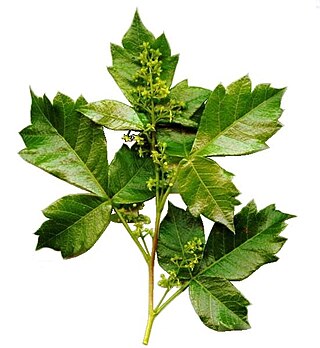
Searsia dentata, the nana-berry (English), or nanabessie (Afrikaans), is a medium-sized, deciduous tree, reaching a height of about 5 metres and a spread of 4 metres, and with a tendency to scramble through and over neighbouring trees. It occurs naturally in almost the whole of South Africa except the Western and Northern Cape Provinces. Its habitat varies from sea level to the highlands of the Drakensberg. It is frost-hardy and should be planted in full sun. The strongly aromatic leaves are usually conspicuously toothed, though sometimes they may be only slightly toothed. The tree produces small, creamy-white flowers in masses, developing into small, flattened drupes (5-6mm) which turn red or orange when ripe and brown when dry. The ripe fruits are eaten by birds, while the foliage is food for the larvae of the pepper tree moth Bombycomorpha bifascia.
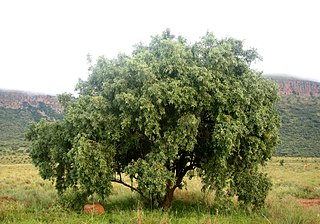
Searsia leptodictya is known as mountain karee in English, bergkaree in Afrikaans, and mohlwehlwe in Sotho. An evergreen tree reaching a height of 5 metres and a similar spread, it is drought resistant but only semi frost hardy. It is an attractive small tree with a rounded crown and a pleasing weeping effect. It can be planted in full sun or in partial shade. The tree bears small white flowers, which on female trees turn into bunches of small berry type fruit, which attract birds who feed on the berries. The tree is an attractive tree for a small garden. The berries can be brewed into a beer.
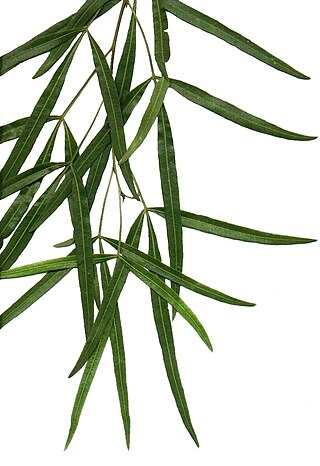
Searsia lancea commonly known as karee, is an evergreen, frost hardy, drought resistant tree, which can reach up to 8 metres in height with a 5-metre spread. It is one of the most common trees on the Highveld and in the Bushveld in South Africa, but not found in the Lowveld. In North America, where it is naturalised, it is known as African sumac and willow rhus.
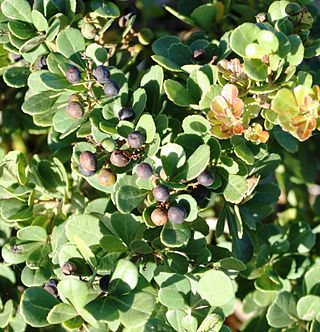
Searsia crenata, previously known as Rhus crenata,, is a species of Searsia that is native to South Africa, where it grows in frost-free and light frost areas, especially on beach sand dunes.
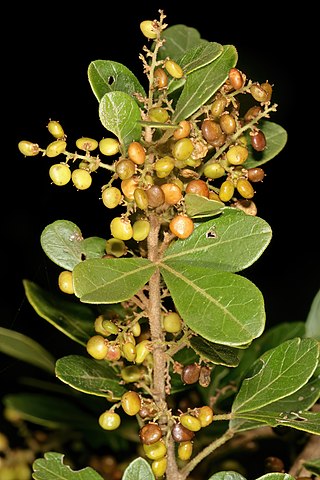
Searsia pentheri, the common crowberry (English), gewone kraaibessie (Afrikaans), iNhlokoshiyane (Zulu), or mutasiri (Venda), is a species of tree in the genus Searsia. Frost hardy tree reaching a height of up to 6 metres. The tree is mainly evergreen but loses its leaves in severe winters. It has olive-green foliage with dark brown bark and can be grown in either full sun or semi shade. Small flowers are produced and are followed by masses of shiny, light brown, small edible fruits, which provide a feast for birds. Only female trees produce these fruits though. The tree occurs over large portions of South Africa. It has been planted in Spain.
Searsia gerrardii, the Drakensberg karee, is a deciduous, drought resistant tree, native to South Africa. It reaches a height of up to 5 metres. It is frost hardy and occurs naturally in mountain areas, often along riverbanks. The tree has a graceful drooping habit. It produces small yellowish flowers which, on female trees, turn into small fruits which are relished by birds. This tree makes a lovely shade tree for a small garden.
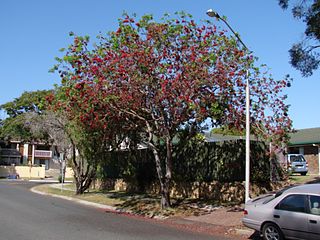
Schotia brachypetala, the weeping boer-bean, is a leguminous flowering tree in the family Fabaceae and the subfamily Detarioideae. The woodland tree is native to Africa south of the Zambezi River, where it occurs at middle altitudes. It is well-suited as shade or ornamental tree in warmer regions, and is consequently widely cultivated in gardens and parks. It is named for the copious nectar that drips from its flowers, which attracts various species of birds and insects. It is known by various other names, including tree fuchsia, African greenheart and African walnut.
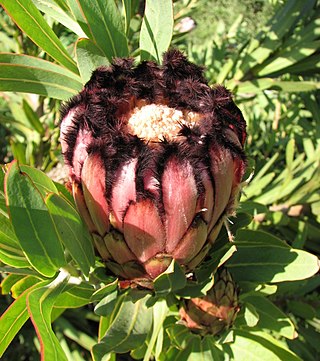
Protea neriifolia, also known as the narrow-leaf sugarbush, oleander-leaved sugarbush, blue sugarbush, or the oleanderleaf protea, is a flowering plant in the genus Protea, which is endemic to South Africa.

Parinari curatellifolia is an evergreen tropical tree of Africa, found in various types of deciduous woodland most frequently in poorly drained areas and inland at moderate altitudes. It is also known as mmupudu, mupundu or mobola plum after the fruit, which is considered tasty and causes the tree to be spared when woodland is cleared for cultivation.

Quercus libani, the Lebanon oak, is a species of oak native to the eastern Mediterranean in western Asia, including in western Syria, northeastern Israel, eastern Turkey, and northern Iraq and Iran. Despite the name, the species is not present in Lebanon.

Celtis africana, the white stinkwood, is a deciduous tree in the family Cannabaceae. Its habit ranges from a tall tree in forest to a medium-sized tree in bushveld and open country, and a shrub on rocky soil. It occurs in Yemen and Somaliland and over large parts of Africa south of the Sahara. It is a common tree in the south and east of southern Africa, where the odour given off by freshly-cut green timber is similar to that of Ocotea bullata or black stinkwood.

Diospyros whyteana is a small African tree of the ebony family. Bearing dark green, strikingly glossy leaves and creamy fragrant flowers, it is increasingly cultivated in Southern African gardens as an attractive and strong ornamental tree. It can attain a height of up to 6 m.
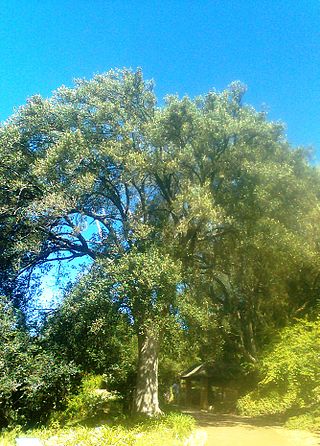
Kiggelaria africana is a large, robust, low-branching African tree, and is currently the only accepted species in the genus Kiggelaria.

Searsia angustifolia, the willow karee or smalblaar, is a small, bushy, evergreen tree which is confined to the South Western Cape in South Africa.
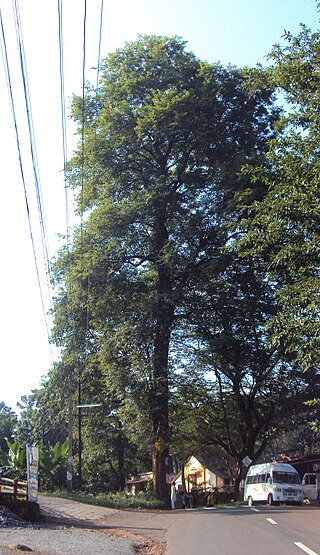
Dalbergia latifolia is a premier timber species, also known as the Indian rosewood. It is native to low-elevation tropical monsoon forests of south east India. Some common names in English include rosewood, Bombay blackwood, roseta rosewood, East Indian rosewood, reddish-brown rosewood, Indian palisandre, and Java palisandre. Its Indian common names are beete, and satisal or sitsal. The tree grows to 40 metres (130 ft) in height and is evergreen, but locally deciduous in drier subpopulations.

Senegalia nigrescens, the knobthorn, is a deciduous African tree, growing up to 18 m tall, that is found in savanna regions from West Africa to South Africa. The tree is resistant to drought, not resistant to frost and its hard wood is resistant to termites.

Euclea crispa, commonly known as the blue guarri, is an Afrotropical plant species of the family Ebenaceae. The hardy and evergreen plants may form a dense stand of shrubs, or grow to tree size. It is widespread and common in the interior regions of southern Africa, and occurs northward to the tropics. Though some are present near the South African south and east coasts, they generally occur at middle to high altitudes. It is readily recognizable from its much-branched structure and dull bluish foliage colour. Those bearing lanceolate leaves may however resemble the Wild olive, another common species of the interior plateaus.






















